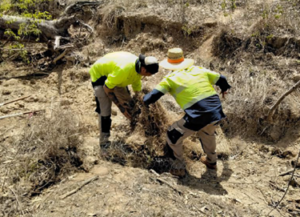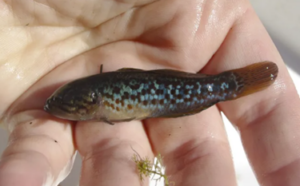This update represents just a handful of NRM projects among hundreds across Australia, which are made possible through funding from the Australian Government, state governments and others.
 Saving wetlands on cropping farms - Glenelg Hopkins Catchment Management Authority, Victoria
Saving wetlands on cropping farms - Glenelg Hopkins Catchment Management Authority, Victoria
The Glenelg Hopkins Catchment Management Authority (GHCMA) are working with the Beyond Bolac Catchment Action Group, Precision Agriculture and four cropping farmers in the Eastern part of the catchment to trial precision agriculture techniques and technology to help farmers maintain their cropping outputs while supporting the wetland environments on their farm.
The region is home to about 22 per cent of Victoria's seasonal herbaceous wetland areas and the majority of these are on privately held farmland with many in the middle of cropped paddocks.
For more information read the Newsletter or visit the GHCMA website.

Upper Murrumbidgee Waterwatch results reveal improved water quality – ACT NRM, Australian Capital Territory
ACT NRM’s 2023 Catchment Health Indicators Program (CHIP) report is in, incorporating findings from 1,946 water quality surveys, 189 waterbug surveys, and 132 riparian condition surveys, conducted by a dedicated team of over 200 volunteers.
For nearly three decades, Upper Murrumbidgee Waterwatch has mobilised volunteers to monitor catchment condition and water quality across an expansive 11,400km2 area.
Overall in 2023, 55% of reaches fell into the excellent/good range which is the best result in the CHIP report’s ten-year history, breaking the previous record set in 2022 and reflecting the favourable environmental conditions fostered by healthy flows and above-average rainfall.
Read more here or access the full CHIP report.

Climate change affecting Numbat feeding habits – Peel Harvey Catchment Council, Western Australia
Outcomes from the Peel Harvey Catchment Council’s recently completed Numbat Neighbourhood Project (2018-2023), point to the need to consider climate change impacts and actions in Numbat Recovery Plans. The study highlights the need for more research into how increasing temperatures will impact numbats and other threatened species as temperatures increase.
Research from Curtin University’s Dr Christine Cooper and Philip Withers used thermal imaging and heat balance modelling to examine the thermal ecology of native animals, including numbats. They found that high environmental heat loads can limit foraging in open areas to as little as 10 minutes, which may impact the animals’ ability to meet their daily calorie needs of around 20,000 termites per day.
Read more here and the ABC News article.

Healing Country Team taking on small scale erosion – NQ Dry Tropics, Queensland
The NQ Dry Tropics Healing Country Team are offering their services to landholders in the Burdekin River region for small scale non-mechanical erosion works.
The project, funded through the Queensland Government’s Reef Assist program under the Queensland Reef Water Quality Program, enables young First Nations people to connect with Country while helping to improve land conditions and reduce sediment run-off in areas where the soils are too fragile for machines to be used.
Hells Gate grazier, Owen Howard said “What’s being achieved…is to fast-track work on badly scalded and eroded sites. Every bit helps, and I do appreciate everyone’s involvement in helping us achieve good outcomes for production and for the environment.”
Read more here and watch the video of project.

Reviving Riverina’s Malleefowl; Project Update - Riverina Local Land Services, New South Wales
Riverina Local Land Services (Riverina LLS) is working with local landholders and managers to help protect Malleefowl habitat and reintroduce Malleefowl to the area through funding under the Australian Government's National Landcare Program.
A 55-hectare predator proof Malleefowl Sanctuary, northeast of Griffith was built in 2018 and is run by Riverina LLS to incubate eggs and provide a safe haven for the independent-from-birth chicks.
Although this year’s breeding season was shaping up to be successful, only 2 chicks were incubated and released into the Sanctuary after soaring temperatures and severe storms affected Malleefowl across the region.
Read the Newsletter, visit the project website or watch Malleefowl safe haven now a reality (youtube.com) for more information.

Watching the Seagrass Grow – Reef Catchments, Queensland
Reef Catchments is coordinating a pilot Seagrass Restoration Project with Central Queensland University to assist recovery of seagrass meadows. Queensland’s seagrass habitats are declining and taking longer to recover from shocks and stresses. To help restore and build resilience in the system, seagrass nurseries have been constructed in tubs on a pontoon at Coral Sea Marina in Pioneer Bay.
The nurseries have seen phenomenal growth rates over the past year, which is attributed to the local seawater being plumbed through the system with only sand filtration. This means a diverse array of 'critters,' including sea hares and razor clams, are also introduced to the nurseries, which may be helping the seagrass to thrive. Seagrass flowers and their seeds are collected and cultivated in the nurseries and then used to re-seed the meadows of Pioneer Bay.
Read the Newsletter article here. Read more about the Seagrass project and the Whitsunday Reef Islands Initiative.

Southern purple-spotted Gudgeons for the Murray–Darling - Murraylands and Riverland Landscape Board, South Australia
Murraylands and Riverland Landscape Board and Nature Glenelg Trust, working with Zoos SA, recently released fifty Southern purple-spotted gudgeons into a waterhole at Monarto Safari Park. The project aims to reintroduce the species to the Murray-Darling Basin and the waterhole is part of a network of Southern purple-spotted gudgeon breeding sites.
Zoos SA’s Conservation Ecologist, Paul Kotz, said “Many small native fish species suffered during the millennium drought and the Southern purple-spotted gudgeon haven’t been seen in the Murray River in South Australia since.”
“Although they are a small fish, they are just as intrinsically valuable to the ecosystem as any other species and it’s rewarding to be making progress in returning this lesser-known native fish to its native habitat,” said Paul.
